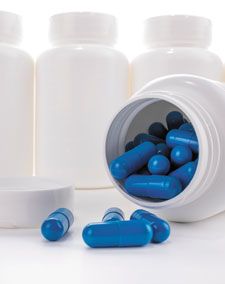Boosting Functionality of Container Closures
Closures that protect solid-dosage drugs and the capping equipment that applies them have new product-protecting features.
Shawn Hill/Shutterstock.com

For solid-dosage forms, capping is a primary operation on the packaging line. Cappers and related equipment integrate seamlessly with up- and downstream systems, ensure proper application and removal torque, maximize overall equipment effectiveness (OEE), and offer quick changeover across a range of cap sizes and styles.
Caps, or closures, not only close the container and protect the product, but often offer additional functionality such as easy dispensing, child resistance, tamper evidence, and shelf-life protection. Demand for additional functionality, particularly child-resistant (CR) and tamper-evident designs, is helping spur a 5% compound annual growth rate through 2020 for pharmaceutical caps and closures, according to a market study from Technavio (1).
Increasing shelf-life
To address stricter requirements related to drug stability, there’s considerable action in closures with enhanced shelf-life protection capabilities. Activ-Seal scavenging closures from CSP Technologies streamline the packaging process for products needing added protection from relative humidity (RH), oxygen, or other gases by building the scavenger into the closure, thereby eliminating the need to purchase and insert a scavenging canister or sachet into each bottle, which also avoids the risk of accidental ingestion. “Depending on the customer’s need, we can maintain target RH that is between a designated set of ranges or draw down close to zero,” says James McGetrick, associate director of Business Development for CSP Technologies. Launched in 2016 and designed to work with existing caps, containers, and packaging equipment, several pharmaceutical manufacturers are completing testing of Activ-Seal closures. “We expect a commercially approved product to enter the market soon,” he adds.
Another built-in scavenger, the Silica Gel Capsule from Italy’s Bormioli Rocco, integrates scavenger and closure. “This solution allows for improvements both in terms of machinability and patient safety,” explains Anna Malori, a member of the business development staff at Bormioli Rocco. “Because the cap contains the desiccant, no additional filling processes are required, and filling times are greatly reduced. Furthermore, this solution avoids the risk of accidental ingestion that can occur with silica gel packets.”
Senior-friendly CR closures
Greater efficiency and sustainability benefits prompted the development of a one-piece, thread-free polypropylene closure by Comar. Designed to replace traditional two-piece push-and-turn CR closures, the senior-friendly Secure-Cap QuarterLoc closure reduces part weight and manufacturing complexity and offers a potential cost savings up to 25%. The bayonet-style neck finish enables application and removal of the closure in a quarter turn and eliminates concerns about application torque, cross-threading, and cocked closures. Compatible with CR and non-CR containers, the closure can be manufactured in standard sizes. It does not require a liner but can accommodate a pulp-backed, glued-in foil induction liner and is compatible with conduction liners, which are heat-sealed in place before the cap is applied. The closure can be applied on standard capping equipment and will not back off after application (2). Although there are no commercial users yet, Sue Benigni, business segment director at Comar notes, “the closure mold is under construction. We have been doing customer trials for gummy vitamin products with several of the major manufacturers.”
Applying consistent torque
Although torque measurement is not a factor when applying the QuarterLoc closure, it’s a critical parameter for many other closure styles. “Manufacturers are moving toward a zero-defect philosophy where applying caps produces reject rates less than 0.5%, and every cap torque application is measured with torque profile monitored for consistency, standard deviation, and conformity,” notes Alan Shuhaibar, president of BellatRx.
Monitoring is particularly important on lines with induction sealing. “To achieve a proper seal, you have to have the proper applied torque,” explains Omar Azam, inside sales manager at NJM Packaging, a ProMach Product Brand.
Shuhaibar agrees. He says monitoring the actual torque applied accomplishes multiple goals: “First, a guarantee of proper induction seal adherence and second, the migration away from the need to test for removal torque when controls are set for application torque.”
Cappers equipped with intelligent torque-monitoring capabilities address this need. For example, the BellatRx Secure Chuck Capper incorporates servo torque technology and advanced software to monitor torque application. “The software behind the torque control on our cappers is sophisticated enough to be able to detect stripped caps and worn grippers,” reports Shuhaibar. The latest monitoring advancement captures the actual torque reading at the cap to measure the torque profile exerted by the servo and make decisions about the pass or fail of each cap going through the capper. Other features of the Secure Chuck Capper include recipe control for easy and repeatable setup and GMP design to maximize cleanability of surfaces and eliminate entrapment areas. Full installation, operational, and performance qualification protocols facilitate the validation and commissioning process.
Figure 1. The NJM Packaging beltorque BT-IC capper monitors applied torque and triggers a reject device to remove capped bottles that are under or over pre-set thresholds. Courtesy of NJM Packaging.

The beltorque BT-IC capper from NJM Packaging (see Figure 1) also monitors applied torque and triggers a reject device to remove capped bottles that are under or over pre-set thresholds. “We can measure applied torque on every container as the cap is applied so we can make sure each one is in specification,” says Azam. To further protect quality, the beltorque capper offers an inspection option. Sensors identify containers with missing or skewed caps and missing induction seals. Another inspection option, using infrared technology from DIR Technologies, can verify the integrity of each induction seal.
On the inline beltorque capper, two pairs of belts gently rotate and tighten caps. Using patented technology, one drive synchronizes the linear displacement speed of the container with the rotating speed of the closure, even when the cap stops turning. This design minimizes slippage to achieve more consistent torque values. It also maximizes product quality by eliminating damage to the cap knurling and cap finish. Rated at 300 bottles per minute, the capper competes with rotary cappers and offers simple mechanics, fast changeovers, and low maintenance. A servo-driven elevator-feeder with cleats that automatically adjust to cap size supports the high-speed operation. A sequential on-demand advance indexes the elevating conveyor, smooths the operation, and reduces compressed air use by 50% to lower energy costs (3). The beltorque capper can orient and place popular, but difficult-to-handle closures, such as gear-shaped and rubberized arthritis screw caps and flip-top screw caps. Without good control, flip-top caps can pop open, notes Azam. “We have devices inside the capper that keep the top closed, and we inspect a cap to make sure it stayed closed,” he explains.
Improving induction seals
Beneath the flip-top cap, an induction seal often provides tamper evidence and protects product quality. Unfortunately, when a consumer removes the cap for the first time, the seal can be hard to remove. A pull tab on the Easy Peel induction liner from Bormioli Rocco solves that problem. Compatible with all of the company’s closures and bottles for solid doses, the tabbed design eliminates the need to use potentially dangerous tools to remove the liner without changing its ability to protect tablets or capsules from humidity, oxygen, and other environmental factors.
Induction liners are fused on bottle orifices by induction sealers. Like many packaging machines, today’s induction sealers use energy more efficiently and require less power than their predecessors. Other features include touch-screen control and integrated cap inspection. “The reason cap inspection is so integral to the success of induction sealing is two-fold,” explains Mark Plantier, vice-president of Marketing at Enercon Industries. “A liner must be present in each cap, and the cap cannot be misapplied in a cocked fashion. Cap inspection is able to detect these variations. Prior to this innovation, cap inspection was controlled by an independent control system. By integrating it both mechanically and electrically into the induction sealer, packagers are able to quickly set up their systems and rely on a single control and diagnostics for both cap inspection and sealing.” Changeover is simpler too. For example, an all-in-one sealing head, designed by Enercon for contract packagers, provides operators with indicators and positive locking mechanisms for properly positioning the head for each application.
Enercon’s Deluxe Cap Inspection package provides even more control. An advanced laser-light curtain for cocked cap detection allows users to set specific tolerances for detecting out-of-spec cap application. The system also offers remote control and monitoring of all data collected by the induction sealer.
To ensure induction sealing performs at the highest OEE possible, Plantier advises looking at the process holistically. Equipment should be designed for the specific sealing application, and induction sealing experts should be involved early in the design process for the cap and bottle. “The type and range of caps, bottles, liners, and line speeds will help the induction sealer manufacturer recommend the best sealer and sealing head for the application,” says Plantier. With equipment properly specified, the original equipment manufacturer should provide detailed setup instructions including alignment, air gap, line speed, and sealing power.
Induction sealing success, however, is dependent on external variables, including the quality of the cap, liner, and container materials, as well as the capping process itself. “Properly torqued caps are required for induction sealing, and in fact, improperly torqued caps are the most frequent cause of partial or failed seals,” concludes Plantier.
References
1. Technavio, “Global Pharmaceutical Caps and Closures Market 2016–2020,” www.technavio.com/report/global-packaging-global-pharmaceutical-caps-and-closures-market-2016-2020, accessed Oct. 31, 2017.
2. Comar, “QuarterLoc Child Resistant (CR) Closure,” Press Release, Undated.
3. NJM Packaging, “NJM Packaging Introduces New beltorque High-Speed In-line Capper,” Press Release, July 8, 2015.
About the Author
Hallie Forcinio is Pharmaceutical Technology’s Packaging editor, editorhal@cs.com.
Article Details
Pharmaceutical Technology
Vol. 42, No. 1
January 2018
Pages: 62–63, 68
Citation
When referring to this article, please cite it as H. Forcinio, "Boosting Functionality of Container Closures," Pharmaceutical Technology 42 (1) 2018.

Drug Solutions Podcast: A Closer Look at mRNA in Oncology and Vaccines
April 30th 2024In this episode fo the Drug Solutions Podcast, etherna’s vice-president of Technology and Innovation, Stefaan De Koker, discusses the merits and challenges of using mRNA as the foundation for therapeutics in oncology as well as for vaccines.
Entering New Domains for 3D Printing of Drug Products
April 6th 20253D printing of personalized medications is currently possible under existing compounding regulations, offering enhanced process control through automation. But new legislation coming in 2025 will allow 3D printing as part of a distributed manufacturing framework.